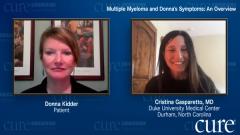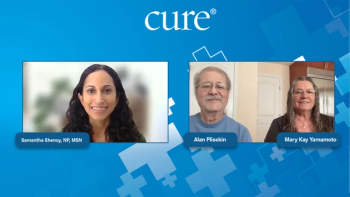
Multiple Myeloma and CAR T Cell Therapy
Donna’s multiple myeloma treatment changes with the help of Dr Cristina Gasparetto’s direct influence and CAR T cell therapy.
Episodes in this series

Cristina Gasparetto, MD: The problem is, when you go from first line, second line, third line, etc, the myeloma becomes a little more resistant to therapy. Sometimes it’s more difficult to sustain the blood count, and you may have more side effects. I think that one of the challenges for us, for a myeloma doctor, is to choose the best therapy for you in that particular situation. The myeloma becomes more aggressive, and now the goals are different. With the initial therapy—the first line, the second—the goals are to achieve the most durable depth of response. Unfortunately, with the third and fourth line of therapy, we will not be able to do that for the majority of patients, so it’s more like we are in a control mode. We give you the best therapy to keep your myeloma from giving you trouble. We keep it at a very low threshold with therapy, so the goal is a little different. There are some combinations that are so strong, sometimes we repeat the transplant; actually the next therapy you received was pretty strong. At this point was when you came to see me and we prepared you for a big deal therapy. We did CAR [chimeric antigen receptor]-T cell therapy, right?
Donna Kidder: Yes, though I did have Darzalex.
Cristina Gasparetto, MD: You did, yes.
Donna Kidder: Briefly, but I didn’t respond very well to it. But then it was the CAR-T, which was very exciting to me because I’d been wanting to try that for a while, and I had a very good response to it.
Cristina Gasparetto, MD: Let’s talk about CAR-T cell a little bit. I don’t know if you’re aware, but the CAR-T cell therapy you received was recently approved by the FDA for patients who have failed four prior lines of therapy. You were part of the big trial. So the CAR-T cell, very briefly, to summarize, is a way to boost your immune system. We take your lymphocytes, and we activate them in a flask. We make them attack specifically your myeloma. We kind of engineered your lymphocytes in a flask to specifically target your myeloma, and then we prepared you with some chemotherapy so you could accept this big…. The T cells are grown in vitro, so we gave you tons of lymphocytes. Angry lymphocytes, active lymphocytes, and their aim is to destroy your myeloma. That is the immunotherapy, and we are boosting your immune system to destroy your myeloma. That is also a one-time shot. You went to the hospital to get the chemotherapy; well, you collect your lymphocytes, then we ship them to the company, they engineer them, and you stay there. I think we were lingering, hoping that your myeloma didn’t get worse. I don’t remember if I gave you some therapy to keep it under control.
Donna Kidder: You did.
Cristina Gasparetto, MD: I gave you carfilzomib again, right?
Donna Kidder: I think so, yes.
Cristina Gasparetto, MD: Then you went to the hospital for a few days, had the chemotherapy, and then we infused. What happened after, you actually didn’t have a lot of the side effects, right?
Donna Kidder: I had a fever for maybe 36 hours. Other than that, I was fine. I was running around the hospital floor waiting for them to let me leave.
Cristina Gasparetto, MD: We are concerned about what we call cytokine release syndrome, where there is so much inflammation because of all these lymphocytes, and we have to give you some medication for that. Now more and more rarely, some patients will develop some neurological symptoms. But all the symptoms that we used to see with the CAR-T cell when it was first introduced for myeloma, and also for other cancers, are mitigated. We know how to handle that. Patients, after the chemotherapy, the infusion, they can go back to being an outpatient and be followed in the outpatient setting. And that’s it. Another good thing about CAR-T cell is that for a while you were off therapy again, right?
Donna Kidder: Oh, it was marvelous. It was marvelous, yes.
Cristina Gasparetto, MD: You like to travel, so that was good; you had time to do your stuff without coming back to the office.
Donna Kidder: I was running 10 miles a week.
Cristina Gasparetto, MD: Good. So the CAR-T cell didn’t cure your myeloma, unfortunately. You stabilized, you responded, and your response lasted, again, for a short period. I think it was not a year, it was between six months and a year, right?
Donna Kidder: It was about seven months. You figure, I was treated in May; I actually didn’t get any subsequent treatment until January. It was back, but it was at a low level.
Cristina Gasparetto, MD: You were off treatment during that time.
Donna Kidder: That’s correct.
Cristina Gasparetto, MD: CAR-T cell unfortunately is not for everybody. It has to be done…at an institution where we have the capability of processing the cells; it’s not for everybody. But we do have very similar—the BiTEs [bispecific T-cell engagers] are not approved yet—but the BiTEs strategy is very similar to CAR-T cell. I don’t know if you’re familiar, they’re an antibody. BiTEs attack your T cells, and with the other, they attack the myeloma, so they destroy. Again, it’s immunotherapy. They are teaching your lymphocytes to attack the myeloma, and you receive the BiTEs continuously. The preliminary data presented were fantastic. The response rates they achieved with the BiTEs, with the CAR-T cell, are very high, but we’re still working. The research field is still invested in improving the durability of responses. Unfortunately, they’re not lasting forever, but we’re getting better and better.
This transcript has been edited for clarity.

